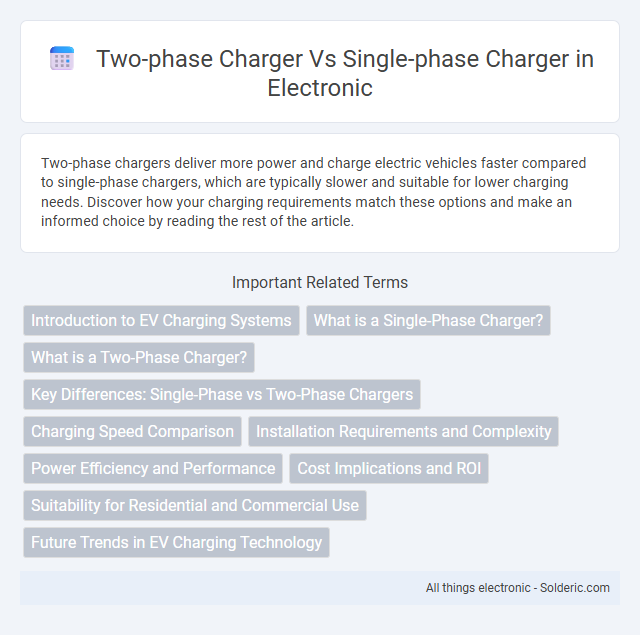Two-phase chargers deliver more power and charge electric vehicles faster compared to single-phase chargers, which are typically slower and suitable for lower charging needs. Discover how your charging requirements match these options and make an informed choice by reading the rest of the article.
Comparison Table
| Feature | Two-Phase Charger | Single-Phase Charger |
|---|---|---|
| Power Supply | Uses two alternating current phases | Uses one alternating current phase |
| Charging Speed | Faster charging due to higher power delivery | Slower charging, limited by single-phase power |
| Efficiency | Higher efficiency in power conversion | Lower efficiency compared to two-phase |
| Installation Cost | Higher, requires specialized wiring and infrastructure | Lower, compatible with standard household wiring |
| Application | Ideal for commercial and fast-charging stations | Suitable for residential and low power needs |
| Complexity | More complex system design and maintenance | Simple design, easier to maintain |
Introduction to EV Charging Systems
Two-phase chargers deliver higher power compared to single-phase chargers, enabling faster electric vehicle (EV) charging by utilizing two alternating current (AC) phases simultaneously. Single-phase chargers operate on one AC phase, making them suitable for residential or low-power charging applications but often resulting in longer charging times. The choice between two-phase and single-phase charging systems significantly impacts EV charging efficiency, infrastructure requirements, and energy consumption patterns.
What is a Single-Phase Charger?
A single-phase charger operates using a single alternating current (AC) voltage phase, commonly found in residential settings where electrical loads are moderate. This type of charger is typically simpler and less expensive than two-phase chargers, making it suitable for charging electric vehicles or devices at lower power levels. Your choice of a single-phase charger ensures compatibility with standard home electrical systems while providing efficient and reliable charging performance.
What is a Two-Phase Charger?
A two-phase charger utilizes two alternating current (AC) phases to deliver higher power levels compared to a single-phase charger, enabling faster charging times for electric vehicles. It typically operates at voltages around 400 volts, providing greater efficiency and reduced charging duration by distributing the electrical load across two phases. This type of charger is commonly used in residential and commercial settings where quicker energy transfer is required.
Key Differences: Single-Phase vs Two-Phase Chargers
Single-phase chargers deliver alternating current through one live wire and a neutral wire, making them suitable for residential charging with lower power output, typically up to 7.4 kW. Two-phase chargers, less common than three-phase but more powerful than single-phase, use two live wires to provide higher amperage and faster charging capabilities, often found in commercial applications requiring up to 11 kW. The key difference lies in the number of active conductors and power capacity, where two-phase systems enable more efficient energy transfer and reduced charging time compared to single-phase chargers.
Charging Speed Comparison
Two-phase chargers deliver significantly faster charging speeds compared to single-phase chargers due to their ability to supply higher power levels simultaneously across two electrical phases. This results in reduced charging times, often cutting the duration by nearly half when charging compatible electric vehicles or devices. If you prioritize rapid charging efficiency, selecting a two-phase charger enhances your overall charging experience.
Installation Requirements and Complexity
Two-phase chargers require more complex installation due to the need for a compatible dual-phase electrical supply and specialized wiring, often necessitating professional assessment and higher upfront costs. Single-phase chargers have simpler installation requirements, typically compatible with standard residential electrical systems, making them easier and more cost-effective to set up. The increased complexity of two-phase installations can lead to longer setup times and increased electrical infrastructure modifications compared to single-phase chargers.
Power Efficiency and Performance
Two-phase chargers offer improved power efficiency by distributing electrical load more evenly compared to single-phase chargers, reducing energy loss and heat generation during charging. This results in faster charging times and better overall performance, especially for high-capacity batteries. Your electric vehicle benefits from a more stable power supply with two-phase technology, enhancing battery lifespan and reliability.
Cost Implications and ROI
Two-phase chargers typically have higher upfront costs due to increased hardware complexity and installation requirements compared to single-phase chargers, which are simpler and less expensive. However, the faster charging times and improved efficiency of two-phase chargers can lead to a quicker return on investment (ROI) by reducing downtime and increasing productivity for your electric vehicle fleet or charging station usage. Evaluating your energy demand and charging frequency is essential to determine which charger type offers the best cost-benefit balance and maximizes your financial returns.
Suitability for Residential and Commercial Use
Two-phase chargers provide higher power output, making them ideal for commercial use where faster charging and multiple vehicles are common, while single-phase chargers are typically sufficient for residential settings due to their lower power capacity and simpler installation. Your choice depends on the scale of usage and charging speed requirements, with single-phase chargers offering cost-effective solutions for home use. Commercial environments benefit from two-phase chargers' efficiency and ability to handle higher loads, supporting business operations effectively.
Future Trends in EV Charging Technology
Two-phase chargers offer faster charging speeds and higher efficiency compared to single-phase chargers, making them a pivotal component in the future of EV charging technology. Advancements in two-phase systems will support increased power delivery, reducing your vehicle's downtime and enhancing overall grid stability through smart load management. As electric vehicle adoption grows, two-phase chargers are poised to become the standard, enabling quicker, more reliable charging infrastructure to meet rising demand.
two-phase charger vs single-phase charger Infographic

 solderic.com
solderic.com